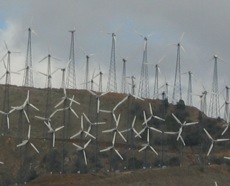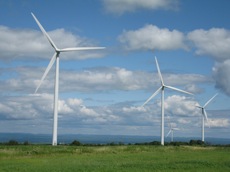
Wind power generators added nearly 40% to their total capacity in the US last year, as several states blew past California, according to a new report from the Department of Energy’s Lawrence Berkeley National Lab. According to the tally, four states now generate more than 10% of their total electricity (excluding exports) from wind.
Texas is the undisputed leader in the wind race, installing nearly 2,300 megawatts of capacity last year alone. Other Midwestern states such as Indiana, Iowa, the Dakotas and Minnesota have also been aggressive installers of wind farms.
California ranks third in total wind capacity (2,798 MW) but only 12th in the

volume added last year. Even states like Oregon and New York, where expansion of wind farms has been controversial, added more capacity last year. California also ranks relatively low in the percentage of total electricity from wind, at just 3.4%, though the state is poised to make a major move with the recent groundbreaking for Terra-Gen’s Alta Wind Energy Center in Kern County.
One of the report’s co-authors, Mark Bolinger, explained in an email that transmission constraints and California’s exhaustive (some say exhausting) site permitting process are factors in the state’s wind slowdown, “In addition, California’s wind resource tends to be concentrated in a handful of ‘wind passes’ (e.g., Altamont Pass, San Gorgonio Pass, Tehachapi, etc.), all of which already contain lots of wind turbines built since the 1980s.” Bolinger adds that ideally, many of those older projects should be “repowered” with newer turbines.
The report also notes that while the US still has the most total capacity installed, China has leapfrogged the US in the pace of its build-out. Also, the US currently has no offshore wind generation, a mainstay in places such as Scotland and Denmark. Though several projects are in the works (the report makes note of “accelerated activity”), little of that is happening on the west coast. Plans for major wind installations in Lake Ontario have encountered public resistance from residents in upstate New York, and the prolonged battle over the Cape Wind project off Massachusetts is now the stuff of legend.
Despite the glacieresque pace of offshore projects, the reports says that for two years running, wind has outpaced all other new generation, except for natural gas.
The entire 88-page wind report, a shorter summary and PowerPoint presentation are all available as PDF downloads at the Lab’s website.
Also today: Oakland-based BrightSource Energy announced that a siting committee at the California Energy Commission has recommended moving forward with the company’s Ivanpah solar plant. Brightsource describes the project as the “largest solar energy project in the world” and claims that if approved by the full commission, it will nearly double the nation’s total output from solar-thermal arrays.
Follow the KQED News multimedia series: “33 x 20: California’s Clean Power Countdown,” with radio reports, blog posts and interactive features.
